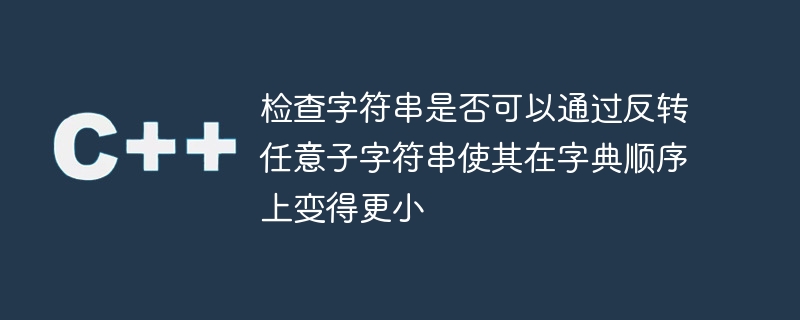检查字符串是否可以通过反转任意子字符串使其在字典顺序上变得更小
- WBOYWBOYWBOYWBOYWBOYWBOYWBOYWBOYWBOYWBOYWBOYWBOYWB转载
- 2023-08-29 22:21:121160浏览

在C++中,我们有一个内置的reverse()函数,用于将子字符串反转,以检查一个字符串是否可以按字典顺序变得更小。字典顺序是将单词的字符按照字典顺序排序的过程。
让我们以一个字符串的例子来检查字典顺序是否较小。
我们将比较这两个单词以检查字典顺序较小的单词,并采用两个字符串,即 'apple' 和 'army'。这两个字符串的第一个字母都以字母 ‘a’ 开头。当我们检查两个字母的第二个字符时,按字母顺序,‘p’ 位于 ‘r’ 之前。因此,按字典顺序,apple比army要小。
在字符串“tutorialspoint”中,将子字符串“oria”反转得到“airo”,该子字符串在字典序中较小。然后将最终字符串写为“tutairolspoint”。
在字符串“tutorix”中,将子字符串“tori”反转得到“irot”,因为第一个子字符串的起始字符是‘t’,第二个子字符串是‘i’,所以‘i’在字母表中位于‘t’之前,因此‘irot’在字典序上小于‘tori’。最后的字符串写作“tuirotx”
我们将采用另一个字符串示例,例如“acwz”。
语法
reverse( str_name.begin(), str_name.end() )
说明
reverse函数是C++标准库的一部分,它接受两个参数“str_name.begin()”和“str_name.end()”。
str_name 是用户建议的字符串名称。
begin() 和 end() 是预定义的内置函数,在反向函数下使用。 begin 函数的工作是返回一个指向输入字符串的第一个字符的迭代器。 end 函数的作用是返回一个迭代器,该迭代器指向输入字符串最后一个字符之前的一个位置。
请注意,reverse函数不会返回任何内容,因为它直接修改了容器(str_name)。
算法
首先,我们将使用三个必要的头文件,即 iostream、string 和 include
我们将从主函数开始,其中声明一个名为‘str’的字符串变量,并将字符串‘tutorialspoint’存储在其中。然后,我们将声明布尔变量‘isReverse’为‘false’,以表示给定的字符串未被反转,仍为原始形式。
然后我们将创建两个嵌套的 for 循环来检查 ‘str’ 的每个可能的子字符串。然后将子字符串存储在名为 ‘temp’ 的临时字符串中。
之后,我们调用 'reverse()' 函数来反转索引 'i' 和 之间存储在 'temp' 变量中的子字符串'j'。
后来创建一个if语句来检查反转后的字符串是否按字典顺序小于变量‘temp’和‘str’进行比较。
编译器将比较变量 temp 和 str。如果它们都相等,那么变量 ‘isReverse’ 将被设置为 true,并且它将中断 if 语句。
现在,我们检查 isReverse 的值,如果为 true,则打印 if 条件语句,否则打印 else 条件语句。
退出程序。
示例
在这个程序中,我们将了解如何通过反转任何子字符串来使字符串按字典顺序变小。
#include <iostream>
#include <string>
#include <algorithm>
using namespace std;
int main() {
string str = "tutorialspoint";
// User can change this to test other strings such as acwz, groffer, etc
bool isReverse = false; // it is used to indicate whether or not a substring has been found in the original string “str”.
// use the loop through all possible substrings of str
for (int i = 0; i < str.length(); i++) {
for (int j = i+1; j < str.length(); j++) {
string temp = str;
// create new temporary variable to store the value of str.
// reverse the substring of i and j
reverse ( temp.begin() + i, temp.begin() + j + 1 );
// reverse function follow the header file name as <algorithm>
if (temp < str) {
// Check whether the reversed string is lexicographically smaller
isReverse = true;
break;
}
}
}
if ( isReverse ) {
cout << "Yes, this is lexicographically smaller by reversing a substring." << endl;
} else {
cout << "No, this is not lexicographically smaller by reversing a substring." << endl;
}
return 0;
}
输出
如果我们输入值“tutorialspoint”,我们会得到以下结果 -
Yes, this is lexicographically smaller by reversing a substring.
如果我们输入值“acwz”,我们会得到以下结果:
No, this is not lexicographically smaller by reversing a substring.
结论
我们看到了如何通过反转任何子字符串来使用字符串变量来计算字典中较小的值。然后我们将字符串变量设置为临时变量。然后我们使用预定义的函数“reverse()”以相反的形式计算词典单词。接下来,我们通过比较变量temp和str来检查字典序较小的并得到结果。
以上是检查字符串是否可以通过反转任意子字符串使其在字典顺序上变得更小的详细内容。更多信息请关注PHP中文网其他相关文章!

